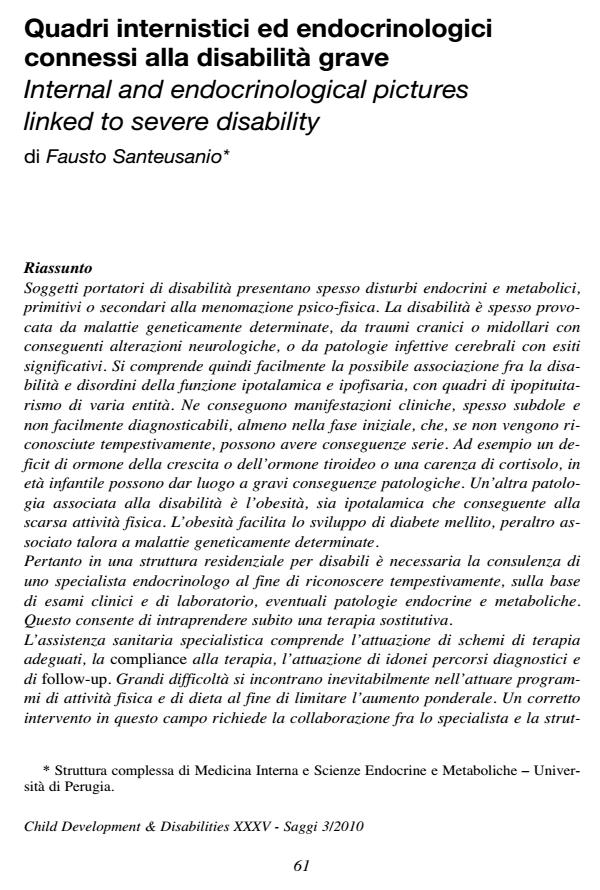Internal and endocrinological pictures linked to severe disability
Journal title CHILD DEVELOPMENT & DISABILITIES - SAGGI
Author/s Fausto Santeusanio
Publishing Year 2012 Issue 2010/3
Language Italian Pages 6 P. 61-66 File size 53 KB
DOI 10.3280/CDD2010-003010
DOI is like a bar code for intellectual property: to have more infomation
click here
Below, you can see the article first page
If you want to buy this article in PDF format, you can do it, following the instructions to buy download credits

FrancoAngeli is member of Publishers International Linking Association, Inc (PILA), a not-for-profit association which run the CrossRef service enabling links to and from online scholarly content.
Persons with disabilities often have endocrine and metabolic disorders that are independent of them, or depend on the mental and physical impairment. Disability is often caused by genetically determined diseases, by head or spinal cord injuries with subsequent neurological disorders, or by brain infectious diseases with significant outcomes. Therefore, we understand easily how a relationship between disability and disorders of the hypothalamic and pituitary function could exist, where hypopituitarism is of different entities. This leads to clinical manifestations that are often subtle and not easily diagnosed, at least on their on-set, and that can have serious consequences if they are not immediately recognized. For example a deficiency of growth hormone or thyroid hormone or cortisol in the childhood lead to severe pathological consequences. Another disease associated with disability is obesity, which is a result of the hypothalamic disorder or of poor physical activity. Obesity facilitates the development of diabetes mellitus and sometimes is associated with genetically determined diseases. Therefore in a residential structure for disabled persons the advice of an endocrinologist is required, in order to recognize timely any endocrine and metabolic pathologies, on the basis of clinical and laboratory tests. This allows undertaking a substitution therapy. Specialist health cares includes implementation of appropriate therapy schemes, compliance to therapy, implementation of appropriate diagnostic and follow up paths. Great difficulties are met inevitably when programs of exercise and diet to control weight gain have to be included. The correct action in this field requires collaboration between the specialist and the residential structure that assists the disabled and means to support such activities also through agreements ad hoc. Finally, it is essential to optimize a well-integrated multidisciplinary assistance.
Keywords: Disabilities, endocrine metabolic disorders, obesity, diabetes, substitution therapy
Fausto Santeusanio, Quadri internistici ed endocrinologici connessi alla disabilità grave in "CHILD DEVELOPMENT & DISABILITIES - SAGGI" 3/2010, pp 61-66, DOI: 10.3280/CDD2010-003010